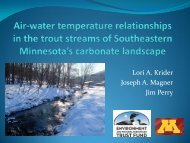Minnesota Water Resources Conference - Water Resources Center ...
Minnesota Water Resources Conference - Water Resources Center ...
Minnesota Water Resources Conference - Water Resources Center ...
You also want an ePaper? Increase the reach of your titles
YUMPU automatically turns print PDFs into web optimized ePapers that Google loves.
BOOK OF ABSTRACTS<br />
Tuesday, Monday, October 27 23<br />
Poster Session 4:45–5:45<br />
Application of Wireless and Sensor Technologies for Urban <strong>Water</strong> Quality Management: Pollutant<br />
Detection in Urban Streams<br />
Michael Henjum, University of <strong>Minnesota</strong>, henj0016@umn.edu; Chris Wennen, University of <strong>Minnesota</strong>; Jim Kang, University<br />
of <strong>Minnesota</strong>; Miki Hondzo, University of <strong>Minnesota</strong>; Paige Novak, University of <strong>Minnesota</strong>; William Arnold, University of<br />
<strong>Minnesota</strong><br />
Widespread water quality threats including insecticides, herbicides, pharmaceuticals, estrogens and other<br />
anthropogenic pollutants have recently been detected within our urban water systems. Direct detection of<br />
these compounds is labor intensive and expensive, thus surrogate measurements are desirable. Using a realtime<br />
wireless network and high frequency sensor to collect data throughout the 2008 year, correlations between<br />
fundamental water quality parameters and emerging chemical contaminants will be established. These results<br />
will subsequently enable mechanistically-based scaling and forecasting of water quality in urban streams<br />
and rivers. Future planning and management of stormwater best management practices can be enhanced<br />
accordingly.<br />
Results will be presented in the fall 2008 conference.<br />
Brooklyn <strong>Center</strong> TIF District 3 Regional Stormwater Treatment Facility<br />
Todd Hubmer, WSB & Associates, Inc., thubmer@wsbeng.com; Todd Blomstrom, City of Brooklyn <strong>Center</strong>; Paul Hudalla, WSB &<br />
Associates, Inc.<br />
As available land becomes scarce and land costs increase in <strong>Minnesota</strong>’s metropolitan areas, underground<br />
stormwater treatment systems become a more economically feasible means to treat stormwater runoff. After<br />
considering several options to treat stormwater runoff from areas in Brooklyn <strong>Center</strong> slated for redevelopment,<br />
the City determined that an underground regional treatment system was the best solution to serve the needs of<br />
the community.<br />
Construction of the underground facility that serves a 490-acre drainage area (the largest facility of its type<br />
in the State) was completed in November 2008. The facility is designed to retain total suspended solids and<br />
floatable pollutants that flow through the trunk storm sewer that discharges to the Mississippi River.<br />
This presentation will provide results of a cost-benefit analysis used to evaluate stormwater treatment options,<br />
design considerations for the underground facility, and calculated and observed sediment volumes retained in<br />
the facility.<br />
41 <strong>Minnesota</strong> <strong>Water</strong> <strong>Resources</strong> <strong>Conference</strong>, October 27–28, 2008
















